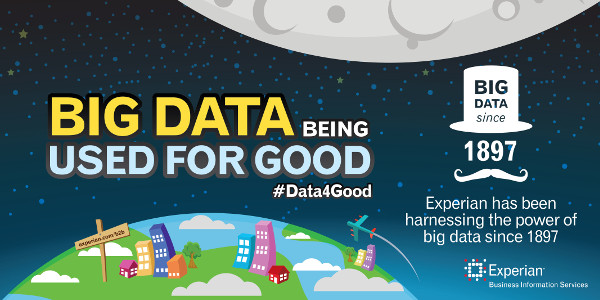Topics

At the recent “Future of Data-Driven Innovation” conference, Emery Simon of the Business Software Alliance noted that each day 2.5 quintillion bytes of data is gathered. How much data is that exactly? To put it into tangible terms, if this data was placed on DVD’s, 2.5 quintillion bytes would create a stack tall enough to go from Earth to the Moon. As Experian’s CEO, Craig Boundy recently blogged, at Experian, we have deep experience harnessing the power of data, in fact; we have been doing it since 1897. Using our insights to help merchants and consumers by providing an annual credit reference directory, we were using “Big Data” before it became a buzz word. You can read Craig’s blog post here. But let’s talk for a moment about the economic impact Big Data can have on society. A recent McKinsey report estimates that improved use of data could generate $3 trillion in additional value each year in seven industries. Of this, $1.3 trillion would benefit the United States. “Improved use of data could generate $3 trillion in additional economic value each year in seven industries.” McKinsey report: Open data; Unlocking innovation and performance with liquid information As consumers, we see the power of Big Data everywhere these days. Local and State governments are using data to tackle policy objectives like kick starting their economies and driving down crime-rates. In health care, Big Data is being used to reduce infant mortality. Researchers analyzing large data sets of vital signs from premature born babies discovered that whenever the vitals seem to stabilize, there is a high probability that a baby will suffer from a dangerous infection just a few hours later. Stable vitals are red flags, and recognizing them enables doctors to treat an infant before the full onset of the infection. And public health agencies are predicting and managing emergencies from the flu to Ebola with big data algorithms. HealthMap.org is an innovative mapping website that uses algorithms to scour tens of thousands of social media sites, local news, government websites, infectious-disease physicians’ social posts, and other sources to detect and track disease outbreaks. When healthcare workers in Guinea started to see patients with Ebola-like symptoms and blogged about their work, a few people on social media mentioned the blog posts. These blog post mentions were picked up by Healthmap. The result, an algorithm using big data told the story of a looming Ebola outbreak nine days before the World Health Organization formally announced the epidemic. Google can predict the spread of the flu, not through mouth swabs or by interviewing doctors, but simply by analyzing billions of search terms they receive from users of their search engine every day. The city of Syracuse, New York wanted to understand why certain neighborhoods declined over time. The city was struggling with abandoned housing, a phenomenon that is often associated with crime, poverty, and health issues. Analyzing local education, social services, economic, real estate, and police data, the city of Syracuse worked with a team of IBM Big Data analysts who demonstrated that certain trends can presage a decline in public safety, property value, and small business growth. Big Data applications in business In 2008 Starbucks CEO, Howard Schultz was forced out of retirement to get the company back on track after closing hundreds of under-performing stores. Starbucks now employs a disciplined data-driven approach to store openings by using Esri’s ArcGIS Online software, a sophisticated mapping platform which blends maps with demographic data. Starbucks can now pinpoint where their new stores should open, where they can be the most successful. Big Data correlations help Amazon and Netflix recommend products to their customers. In automotive manufacturing, predictive maintenance based on Big Data correlations enables companies to predict when a car engine part needs to be exchanged before the part actually breaks. In computer distribution, algorithms which analyze buying trends and payment data from millions of transactions can pinpoint the segment of customers who will soon stop buying. Identifying this cross-section of soon-to-quit customers enables sales organizations to proactively ramp up customer retention strategies to mitigate the risk of lost business. This helps our economy and our businesses thrive. In agriculture, there are companies and universities blending hardware with big data. Apple farmers in the Midwest are using bug traps fitted with sensors that can identify specific types of bugs in the trap. The traps are connected to the Internet in a data portal that the orchard manager can see where an infestation begins and stop it in its tracks. Being able to turn insights into action, farmers can use data analytics on bug infestations to use fewer pesticides, grow their crop more consistently and more profitably. Big data delivers tangible savings to tax payers The U.S. voter registration system is a challenge to manage. List maintenance can be difficult, and the system needs an upgrade. An inaccurate voter registration file can cost the government between $1 and $2 per year. For a state with 5 million voters, this could mean a cost of $0.5 to $2.5 million per year or more in additional costs, depending on the actual condition of the voter file. Orange County, California was able to update more than 297,000 voter records using information from TrueTraceSM, one of Experian’s most powerful data hygiene products. It draws from Experian’s core consumer credit database of more than 220 million consumers and 140 million households, as well as access to 100 million wireless phone numbers. Orange County saved over $44,000 in the first election alone – savings that will grow with each passing election as the county avoids mailing materials to out-of-date addresses. There are a lot of things to be excited about in the realm of Big Data. As Julie Brill, Commissioner of the Federal Trade Commission remarked at the recent Future of Data-Driven Innovation conference, “The data driven economy will not thrive unless the bits of consumer information collected and analyzed are used to benefit the consumer – plowed back into the relationship between businesses and their customers to make it stronger, deeper, and ultimately more profitable.”

Hello, I’m Hiq Lee, president of Experian’s Business Information Services, and I’d like to talk to you about how we are using data for good to help companies, large and small, succeed in the marketplace. At Experian, our group plays a crucial role in the big data ecosystem as an enabler of commerce and insights for the business community at large. We deliver unbiased information on more than 25 million active U.S. businesses, plus our international data capabilities, enable our customers to make more confident decisions on companies overseas. In 2012, along with Moody’s Analytics, we developed the Small Business Credit Index, which provides a unique perspective on the health of small businesses in the United States. The report contains important trends on bankruptcy rates, delinquencies, and overall payment behavior, as well as macro-economic information. This deeper look at the business landscape helps financial institutions and businesses every day to make sound lending decisions, gain key insights on business credit health and prospect for the right customer. At Experian, we are committed to delivering quality data and are strategically focused on the innovation of new and advanced products and services that enable businesses to thrive. Whether it’s analyzing millions of business credit transactions to generate industry-leading commercial credit scores and business credit reports, or safeguarding and securing millions of records to protect businesses and their customers from fraud, Experian is at the forefront of big data, driving value for our customers the world over. For Experian’s Business Information Services, using our data for good means constantly innovating and looking for ways to benefit businesses, as well as consumers and the overall economy. Related Data Is Good - Analytics Make It Great - Craig Boundy, CEO

According to a recent United States Department of Commerce Economic Statistics and Administration report, world trade volume for goods and services is expected to increase 5.3 percent in 2015, up from 3 percent in 2013. Working with companies overseas can have a lucrative impact on your business, however, the opportunity does not come without risk. There are many potential pitfalls to expanding overseas that must be addressed in order to mitigate risk and improve profitability. Three of the major information-based hurdles that should be considered are: 1 - Availability - International data often is unavailable to credit professionals or it takes them too long to acquire. 2 - Freshness - International data is often out-of-date, increasing the chance of making inaccurate risk assessments. 3 - Consistency - Credit professionals can’t use the same analytical models across multiple geographies due to data differences. Experian makes it easy for our customers to expand into new territories through our enhanced international capabilities. We provide comprehensive insight into your international customers and vendors — both prospects and existing — that is accurate, up-to-date, easily accessible and highly actionable. This data helps you assess risk, reduce exposure to late payments and defaults, and be more competitive overall. In the below video Experian product manager, Greg Carmean discusses some of the challenges in international business engagements. Experian’s International Developed Profiles help Rubicon Project safely expand into untapped markets Rubicon Project is a technology company that automates the buying and selling of digital advertising. Their trading platform reaches a global audience of 200 million U.S. and 646 million global monthly visitors. Before they began using Experian, the company was hesitant to grant credit internationally due to the limitations of its previous sources. Rubicon Project is focused on rapidly expanding into new territories while providing world-class service and minimizing risk. In some geographic regions, online ad trading is a new concept that is generating considerable excitement, but this poses the challenge of being able to adequately navigate risk in uncharted waters. "With Experian's Business Information Services, we have access to comprehensive information that helps us uncover new growth opportunities," said Lorraine Moses Rubicon Project’s director of credit and collections. Most recently, Rubicon Project has been challenged with monitoring customers located in high-risk countries affected by recent economic challenges in the Eurozone and Latin America. “Experian simply has updated information on many of the customers of concern,” Moses, continued. “We have been able to grant credit to a large number of international customers that would have been declined because we were unable to determine credit worthiness due to limited information.”
